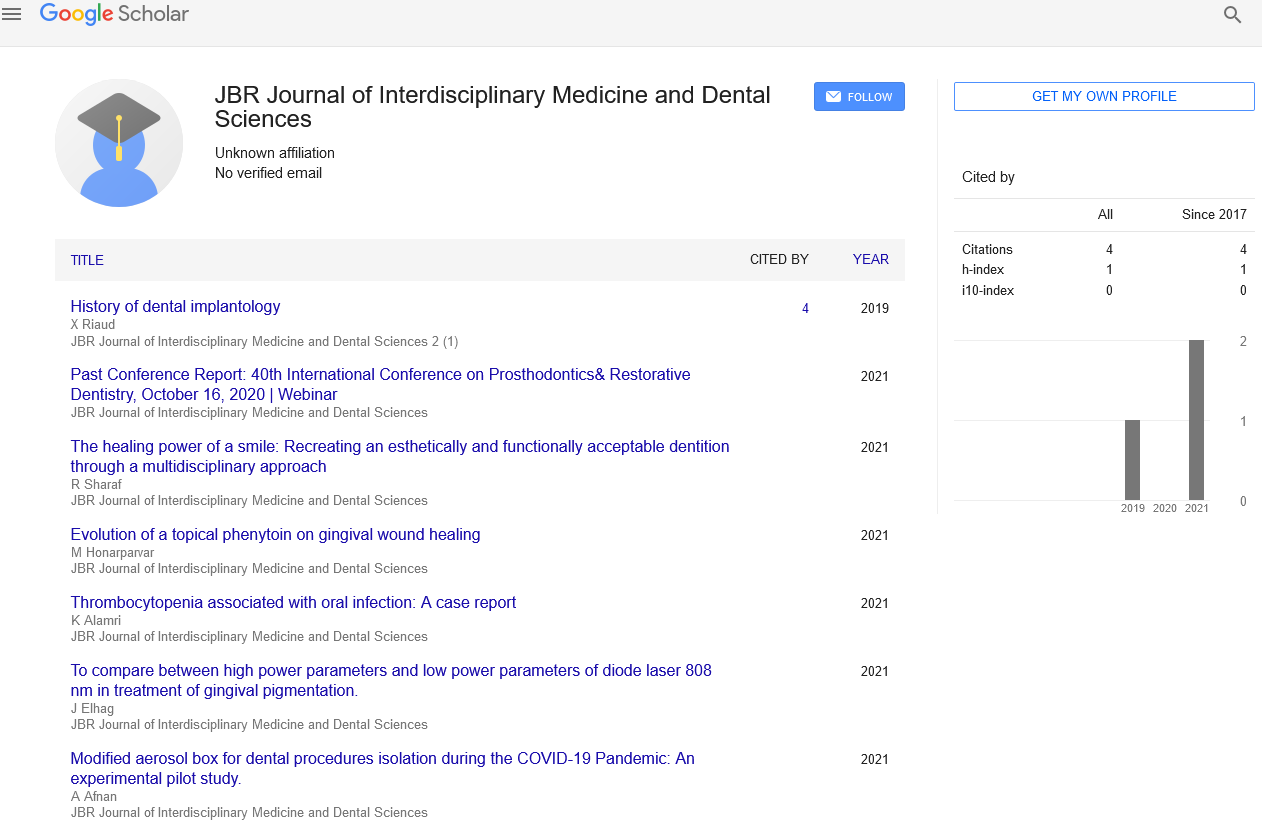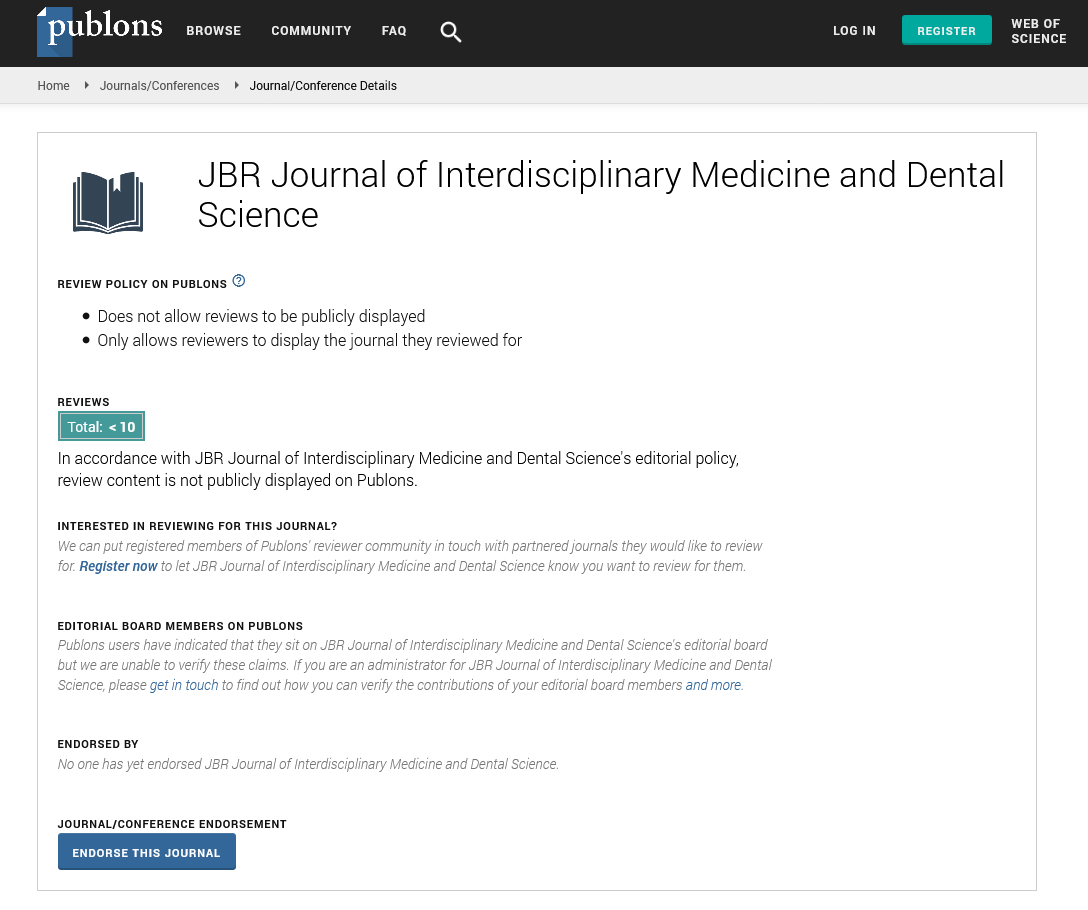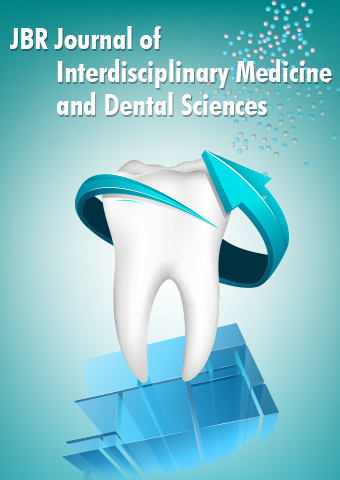Short Communication - JBR Journal of Interdisciplinary Medicine and Dental Sciences (2018) Volume 1, Issue 1
The importance of salivary assessment in dental practice
Jeff Burgess
University of Washington, USA
Abstract
Saliva is becoming an important diagnostic tool for the immediate assessment of oral as well as systemic disease. Its potential as a diagnostic aide was recognized in 2002 by the US based National Institute of Dental and Cranio-facial Research (the NIDCR). Since then, research groups throughout the US and other countries have been studying saliva and point of care (POC) measuring platforms to validate their use for immediate assessment of disease.
The benefits of using saliva as a biomarker for disease are many. Collection of fluid is non-invasive and easily accomplished by the patient or provider in the clinical setting. Relative to collection of serum, collection cost and clotting, acquiring saliva is relatively inexpensive and clotting wouldn’t be a problem. Saliva contains physiological markers for many conditions, both systemic as well as those localized to the oral environment. POC saliva assessment would provide a simple alternative for screening outside the clinical setting and for purposes of treatment monitoring and for epidemiological research or public health screening. POC devices using saliva that are being developed for periodontal disease and oral cancer diagnosis, as well as the diagnosis of systemic diseases, coupled with improved medical and dental electronic software communication could lead to more accurate disease tracking of patients by providers and via the internet, by the various digital devices for information gathering that are being developed.
However, it should be appreciated that current development of medical micro-devices utilizing saliva as a substrate for identifying disease continues to be limited by a number of factors including the fact that definitive molecular biomarkers for many diseases of interest are not yet available; fluid volumes continue to remain a limiting factor; RNA fragment amplification remains a problem; and the sensitivity and specificity for many salivary markers still needs confirmation. Ongoing science should help to solve some of these problems. As of this writing, there are several clinical trials assessing programmable bio-nano-chips (PBNCs) that can assay nucleic acids, proteins, and cells in saliva specific to several pathologic conditions including cardiac heart disease, oral cancer, ovarian cancer, and prostate cancer and there is one marketed device currently available for assessing periodontal disease.
Here are some specific examples involving the use of saliva as a biomarker that underscore why there is such excitement about its use as a disease marker.
Brain Research. In a 2017 abstract presented at a Pediatric Academic Societies Annual Meeting in San Francisco, and subsequently in the Journal of Neurotrauma2, micro-RNA fragments found in saliva were found to be predictive of pediatric brain concussion in children with traumatic brain injury. Micro-RNA fragments are short (length: 19–24 nt) non-coding molecules that are important in regulating numerous cellular processes including those involving the brain. This preliminary research suggests that salivary microRNA fragments easily acquired and measured in the clinical or nonclinical setting, may be useful for identifying pediatric traumatic brain injury (TBI). In one study test was shown to be 90 percent accurate, in contrast to the concussion survey now commonly used that has less that 70 percent accuracy.
Systemic disease: Researchers have identified potential salivary transcriptomic profiles for other diseases such as acute myocardial infarction, diabetes mellitus, Sjogren’s syndrome, cystic fibrosis, and Parkinson’s disease in addition to breast, pancreatic, ovarian, and gastric and lung cancer and melanoma.
Sjogren’s syndrome: Saliva constituents found in the acinar cells of the saliva glands, such as α-enolase, carbonic anhydrase I and II, and salivary α-amylase fragments as well as lysozyme C, polymeric immunoglobulin receptor (pIgR), and calgranulin appear to be altered in Sjogren’s syndrome, an autoimmune disorder that causes, among other symptoms, dry mouth and dry eyes. There is also evidence that the micro RNA profiles of minor labial salivary glands differ between normal subjects and those with SS. The accumulated studies suggest that proteomic salivary constituents used as biomarkers may prove useful in the development of a diagnostic panel that can be used at point of care to identify patients with Sjogren’s syndrome.
Oral Squamous Cell Carcinoma (OSCC): Salivary micro-RNAs may prove useful as biomarkers in the early detection of oral cancer. These cellular fragments are known to have an effect on cell growth, proliferation, and apoptosis and also appear to serve as oncogenes within different cancer types. Biomarkers such as IL-8 may discriminate patients with OSCC from healthy controls. Studies suggest that other proteomic salivary biomarkers potentially useful in detecting OSCC include Cyfra 21-1, tissue polypeptide antigen (TPA), and cancer antigen CA125. And Five salivary proteins (M2BP, MRP14, profilin, CD59, and catalase) appear to discriminate oral cancer with 90% accuracy.
Viral Disease: Viral DNA, RNA, and micro-RNA proteins or salivary antibodies in saliva now allow the identification of viruses. Viral diseases identified by salivary biomarkers include norovirus, rabies, human papillomavirus (HPV), Epstein-Barr viral disease, herpes simplex, hepatitis C, cytomegalovirus (CMV) conditions, and HIV With the morbillivirus virus that causes measles infection, the presence of salivary antibodies demonstrates 97% sensitivity and 100% specificity, for paramyxoviridae virus (that causes mumps) 94% sensitivity and 94% specificity, and for the togaviridiae virus (that causes rubella), 98% sensitivity and 98% specificity Antibodies used to diagnose HIV infection are also found in saliva and salivary assays have been shown to be as accurate as those associated with serum, particularly when plasma virus exceeds 50 copies/ml (when there is active disease). A commercial product called OraQuick has been FDA approved and is available for assessing HIV antibodies in saliva. The testing kit contains a collection stick, test tube, and testing information/directions. It is reported to be able to detect antibodies to HIV-1 and HIV-2 within 20 minutes.
Periodontal Disease: A number of salivary constituents have been considered as potential biomarkers for periodontal disease including DNA from specific bacteria, inflammatory cytokines that are host-derived, cell death host-derived proteins, and enzyme, protein, or calcium derived factors from bone destruction. Recent advances in salivary research suggest that the diagnosis of periodontal disease and its progression may be effectively tracked via integration of biologic measures (e.g. the presence of a number of specific biomarkers in saliva) with standard clinical and radiologic measures.
There are currently two point-of-care devices that have been developed for the salivary diagnosis of periodontitis: one is called the Integrated Microfluidic Platform for Oral Diagnostics (IMPOD), the other is a Lab-on-a-chip (LOC) system developed by the University of Texas. The IMPOD measures MMP-8 (a neutrophil collagenase, also known as matrix metalloproteinase-8), TNF-α (a tumor necrosis factor), IL-6, and CRP (C-reactive protein) in saliva and the LOC measures CRP, MMP-8, and IL-1β. The LOC has shown good comparative accuracy with the enzyme-linked immunosorbent assay (ELISA). The LOC device is currently undergoing clinical trials: (NCT02403297 at ClinicalTrials.gov).
The ongoing research and the multiple devices that are presently being developed are a reflection of the future of salivary diagnostics for many oral and systemic diseases.
References
- Mikkonen JJ, Singh SP, Herrala M, Lappalainen R, Myllymaa S, Kullaa AM. Salivary metabolomics in the diagnosis of oral cancer and periodontal diseases. J Periodontal Res. 2016 Aug; 51(4):431-437.
- Hicks SD, Johnson J, Carney MC, Bramley H, Olympia RP, Loeffert AC, Thomas NJ. Overlapping MicroRNA Expression in Saliva and Cerebrospinal Fluid Accurately Identifies Pediatric Traumatic Brain Injury. J Neurotrauma. 2018 Jan 1;35(1):64-72.
- Aro K, Wei F, Wong DT, Tu M. Saliva Liquid Biopsy for Point-ofCare Applications. Frontiers in Public Health. 2017; 5:77.
- Hu S, Wang J, Meijer J, Leong S, Xie YM, Yu T, Zhou H, Henry S, Vissink A, Pijpe J, Kallenberg C, Elashoff D, Loo JA, Wong DT. Salivary proteomic and genomic biomarkers for primary Sjögren’s syndrome. Arthritis & Rheumatism. 2007; 56:3588– 3600.
- Yuhua Wang, Guohua Zhang, Lingling Zhang, Miansong Zhao, and Hongdong Huang.
- Decreased microRNA-181a and −16 expression levels in the labial salivary glands of Sjögren syndrome patients. Exp Ther Med. 2018 Jan; 15(1): 426–432.
- Elashoff D, Zhou H, Reiss J, et al. Pre-Validation of Salivary Biomarkers for Oral Cancer Detection. Cancer epidemiology, biomarkers & prevention : a publication of the American Association for Cancer Research, cosponsored by the American Society of Preventive Oncology. 2012; 21(4):664-672.
- Hu S, Arellano M, Boontheung P, Wang J, Zhou H, Jiang J, Elashoff D, Wei R, Loo JA, Wong DT. Salivary proteomics for oral cancer biomarker discovery. Clin Cancer Res. 2008; 14:6246– 6252
- Corstjens PL, Abrams WR, Malamud DSaliva and viral infections. Periodontol 2000. 2016 Feb; 70(1):93-110.
- Vijaylakshmi P, Muthukkaruppan VR, Rajasundari A, Korukluoglu G, Nigatu W, Warrener LA, Samuel D, Brown DW. Evaluation of a commercial rubella IgM assay for use on oral fluid samples for diagnosis and surveillance of congenital rubella syndrome and postnatal rubella. J Clin Virol 2006; 37: 265–268.
- Balamane M, Winters MA, Dalai SC, Freeman AH, Traves MW, Israelski DM, Katzenstein DA, Klausner JD. Detection of HIV-1 in Saliva: Implications for Case-Identification, Clinical Monitoring and Surveillance for Drug Resistance. Open Virol J. 2010; 4:88- 93.
- Pascoe SJ, Langhaug LF, Mudzori J, Burke E, Hayes R, Cowan FM. Field evaluation of diagnostic accuracy of an oral fluid rapid test for HIV, tested at point-of-service sites in rural Zimbabwe. AIDS Patient Care STDS. 2009; 23:571–576.
- Ebersole JL, Nagarajan R, Akers D, Miller CS. Targeted salivary biomarkers for discrimination of periodontal health and disease(s). Frontiers in Cellular and Infection Microbiology. 2015; 5:62.
- Herr, A, et al. Integrated Microfluidic Platform for Oral Diagnostics. Ann. N.Y. Acad. Sci. 2007;1098: 362–374.


